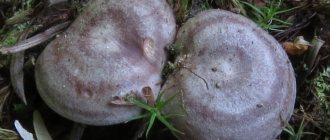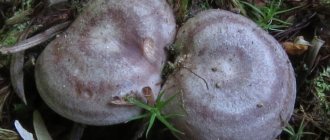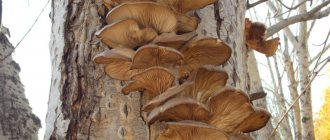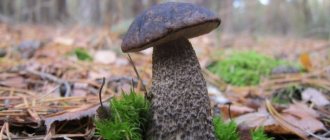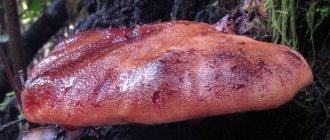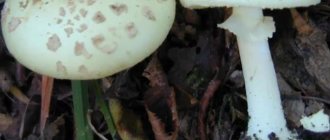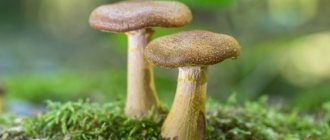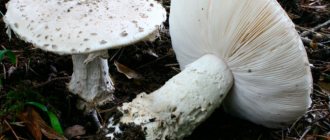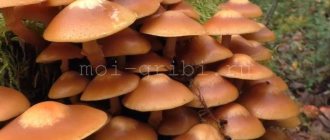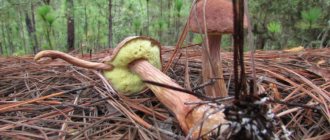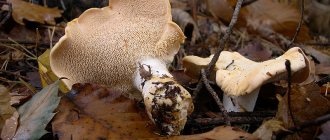Mushrooms grow in certain places for a reason. According to their morphological characteristics, they need different conditions. The pine forest contains a huge variety of different mushrooms, but not all of them grow the same. There are symbiont mushrooms, that is, those that need a partner for life - a tree of a certain species.
With it they form mycorrhiza - a relationship due to which the mushroom receives carbohydrates from tree sap, and the tree from the mushrooms receives water, minerals, and trace elements. There are couples where partners do not change, and on the contrary, there are those where there are variations. This is exactly the situation with pine trees: they interact with a large list of fungi.
A separate group of fungi are saprophytes, or saprophages. These are organisms that settle on a diseased tree, a fallen tree, on stumps, and process the wood, turning it over the years into a fertile layer of soil. This is why the forest land is so rich. Saprophytes also have representatives who love pine wood.
Types of mushrooms, appearance
Many people often like to walk in the forest and pick mushrooms. But it is worth knowing what edible mushrooms look like in a pine forest, so as not to make a mistake and accidentally pick inedible mushrooms, which can be dangerous to health and life. In a pine forest or under spruce trees you can find mushrooms of different colors with different names and tastes that are allowed to be eaten. There are gray and brown mushrooms, and you can also find white mushrooms and any other color in the coniferous and pine forests.
There are the following main types of mushrooms growing in pine forests:
- Butter. The oiler is brown in color, yellow inside, and small in size. Since boletus loves warmth, they can often be found at the edge of a field or at the edge of a field.
- Honey mushrooms. It is found not only under pine trees in the forest, but also grows in fields, meadows, or even among bushes. The stem of pine mushrooms is tall and long, and the cap is disc-shaped and dark brown.
- Row. You can find such pine mushrooms in old forests. The mushrooms got their name because they grow in a row. The cap comes in different sizes and sometimes reaches up to 15 cm in diameter.
- Greenfinch . They are part of the row family and are distinguished by their green-yellow color. These are late autumn mushrooms. The stem of the mushroom is straight and slightly wider at the bottom.
- Moss fly. In pine forests you can often find mushrooms that grow in places covered with moss. The moss cap is thick and the leg is high.
- Russula . A fairly popular pine mushroom that is found everywhere. There are many varieties of russula that differ in size and appearance. The stem of the russula is white, and the cap can be of different colors, depending on the environment in which the mushroom grows.
- Chanterelles. A unique mushroom that can be found in pine forests and plantings. The color of the chanterelles is rich orange, and the cap is funnel-shaped.
- Umbrella mushroom. These pine forest mushrooms are distinguished by their thin stalk and outstretched hat, reminiscent of a dome or umbrella.
- Boletus or porcini mushroom. A popular mushroom that many mushroom pickers try to find. The average size of such mushrooms is 30 cm, but sometimes there are specimens whose cap reaches 50 cm in diameter. The leg of the boletus is thick and the cap is round.
It is worth knowing exactly what mushrooms grow in pine trees and which can be eaten, since there are also inedible pine mushrooms, which include the following:
- fly agaric;
- death cap;
- the smell is false.
Soil preparation
The key to successful engraftment of the “seed material” is a properly prepared soil mixture. I’ll tell you about the most suitable substrates for mushrooms.
Straw
This material can be used both as a mushroom substrate and as mulch. But mushrooms will not grow in straw alone - it must be mixed either with forest litter or with rotten organic residues collected from the garden.
A fertile substrate for champignons is also prepared on the basis of straw:
- 50 kg of last year’s manure - horse, cow;
- 15-20 kg of straw;
- 12 kg of gypsum;
- 12 kg of lime.
I put all the ingredients in a pile - I also add organic waste to it. It is important to compact the mass thoroughly, pour water on it and wrap it in film. The heap matures in 15-20 days. I can judge its readiness by the strong smell of ammonia.
Logs
I'll tell you about how I grow mushrooms on a log:
- I take only healthy wood - I soak it in water for 2-3 days.
- Then I move it to a warm and dry place - either in a heated garage, or on a tarp in the sun. I wait for the excess moisture to evaporate.
- I cut out small holes in a checkerboard pattern of 10x10 cm - 4 cm deep, 0.5-1 cm in diameter.
- I place the seed in them and wrap the log in film. I make several holes in the polyethylene for air access.
- I transfer it to a warm (10-20 C) and humid room: for 2-3 months the log will be wrapped in mycelium - a thin white cobweb.
- In a place protected from the wind, in partial shade, I make a hole for the log - I bury it vertically to 30-50% of its length. To disinfect, I sprinkle the soil around with ash. I “plant” the log as soon as the air temperature rises to 15-25 C.
- In dry weather, I water the soil around the log once every 2-3 weeks.
I don’t dig up a log with mycelium in the fall - I insulate it for the winter with compost and rotten leaves.
growing oyster mushrooms on stumps
Sawdust
A popular type of soil mixture for mushrooms is based on sawdust. You can mix them in equal parts with compost, garden soil, and rotted plant debris. Be sure to treat the mass with disinfectant suspensions - potassium permanganate, copper sulfate, boric acid. It wouldn’t hurt to spill it with a solution of a growth stimulator.
Other substrates
I consider the best option for mushrooms to be forest litter or its imitation:
- rotted foliage, pine needles;
- wood dust;
- rotten moss.
Some of the elements can be replaced with last year's garden compost. Wood ash will be a fertilizer and disinfectant for the substrate.
Where, when and how do they grow?
You can find mushroom glades among spruce and pine forests. Many mushrooms grow in September-October, while others can be found at a later time or in the summer during the good rainy season.
Some mushrooms, such as chanterelles, grow in places with high humidity. Other edible mushrooms, such as boletus mushrooms, grow in warm places - on the edges of a pine forest or other parts of a pine forest that receive a lot of sunlight. Some mushrooms cannot be found on the ground, since they grow exclusively on pine trees.
How to propagate mushrooms in the garden: growing milk mushrooms
Dry breast milk, cracker, or white breast milk (Russula delica) has almost no bitterness and no milky juice. The pulp is white with a sweetish, slightly pungent taste. Not everyone likes its bitterness, but after salting or boiling it disappears. Suitable for any dishes, and when salted it is almost as good as real milk mushrooms. Many in the Moscow region consider him a real milk mushroom, which is incorrect.
To prevent the fragile plates of the mushroom from crumbling before cooking, it must be blanched. It is sometimes found in garden plots with birch trees. Its big drawback is the strong worminess of mushrooms. Few people know that dry milk mushrooms produce a powerful wave of fruiting in late autumn, at which time even very large specimens remain worm-free.
If you grow these mushrooms in an area like in a forest and create conditions for its fruiting, in the fall you can collect enough milk mushrooms for pickling. When preparing the seed, you can find out that the spores of dry milk mushrooms, like the spores of chanterelles, do not settle well in solution. You can use a suspension of spores along with pulp.
milk (Lactarius resimus) and nigella mushrooms in the garden ? It is better to do this together with birch. The real milk mushroom (Lactarius resimus) is truly the king of mushrooms in taste. It is a white, then slightly creamy mushroom with a densely pubescent, shaggy edge of the cap. The pulp is dense, brittle, with a pleasant smell. The white, caustic juice turns yellow when exposed to air.
Real milk mushrooms, salted in a cold way, have an exceptionally pleasant texture and taste. Covered with jelly-like juice, the salted milk mushrooms are taken out of the barrel with a smacking sound. There are few things that can compare to them as a snack! In the foothills of the Urals in Bashkiria, during the period of mass harvest of milk mushrooms, a bucket of milk mushrooms costs less than a bucket of potatoes. But, unfortunately, in the European part of Russia, real milk mushrooms are found rarely and in small quantities.
But in garden plots in the Moscow region, where there are birch trees and fairly moist soil, black milk mushroom (Lactarius necator) sometimes appears. In wooded estates, a large milkweed (Lactarius vellereus) often grows . Violin also has an acrid and bitter taste. This bitterness is unpleasant to the taste even after long soaking.
Benefit
Mushrooms growing in spruce or pine forests are quite useful for the human body. In most cases, mushrooms are eaten because they are a relatively dietary and low-calorie product, which consists of 90% water.
Many mushrooms reduce cholesterol in the body and improve the human condition in many other diseases. Also, pine forest mushrooms are often used not only in cooking, but also in cosmetology and medical purposes. Mushrooms growing in pine forests help produce enzymes.
Honey mushrooms
There are several varieties of honey mushrooms (namely real honey mushrooms, and not other representatives of the mushroom kingdom that are similar to them). Some of them begin to bear fruit in August, and summer honey fungus, for example, can even appear in the spring, but all honey mushrooms have one thing in common - these mushrooms grow in the fall, and it is during this period that many of them experience the most massive fruiting. We have dedicated a separate article to honey mushrooms: “Honey mushrooms: summer, autumn, winter and others.” Here I will mention the autumn honey fungus - the most widespread and popular among mushroom pickers.
Autumn honey fungus
It is found in many forests - on stumps, at the base of trees, on their roots and butt, on all kinds of woody remains - always in clusters of several pieces. It appears in August and continues to be found in the forest until November , and when the autumn is warm - even until December . The most massive fruiting is observed in August-September, in separate three “layers” - as knowledgeable mushroom pickers say.
Application
In cooking
Many mushrooms growing in pine trees have very good taste, so they are widely used in cooking. Pine mushrooms are pickled and pickled for the winter; they come out very tasty and crispy. Mushrooms are also added to the soup. They can be used fresh or dried. Fried mushrooms with fresh potatoes turn out delicious.
You can find many interesting and tasty recipes that use pine mushrooms. Pine forest mushrooms are also used for the following purposes:
- winemaking;
- bakery business;
- making sweets;
- creation of rennet cheeses.
In medicine
Pine mushrooms are distinguished by their healing properties. Chanterelles, for example, are useful for people who have impaired liver function, and these mushrooms also have an anthelmintic effect. Boletus or porcini mushroom helps stimulate metabolic processes in the human body. Boletus mushrooms are also indicated for tuberculosis, since they suppress the activity of the tuberculosis bacillus.
Based on some other mushrooms, medicinal extracts are made to fight parasites, treat sore throat, stomach ulcers, bronchial asthma, or get rid of signs of an allergic reaction.
Volnushki
Photo 23. Pink wave. Author: Tocekas.
both types of our trumpets - pink and white - in the middle - second half of September, and I always observed mass fruiting.
Photo 24. White volnushka. Author: AfroBrazilian.
Pink waveweed was found in tall birch forests , white - in young pine-birch woodlands . Both mushrooms bear fruit from summer to early autumn , but the pink one appears earlier than the white one - from the third decade of June , while the white one begins to appear only in August . The mushrooms finish bearing fruit in September , but it seems that the white trumpet does this later than the pink one.
Harm and contraindications
Despite their great benefits, pine mushrooms can also harm humans if they are used or stored incorrectly. Any edible mushroom growing in a pine forest is a heavy food, and therefore is not recommended for people with diseases of the gastrointestinal tract, liver, or impaired kidney function. Dishes with mushrooms are contraindicated for persons who have an allergic reaction to mold.
Even edible mushrooms collected within the city, where there are a lot of cars, are dangerous for any person. This is due to the fact that pine mushrooms, like any other, accumulate toxic substances from the environment.
Poisonous and inedible mushrooms in a pine forest in autumn
Of course, the list does not end with edible mushrooms. All season, and especially in the fall, there are quite dangerous fruits among the pines.
Gorchak. Boletus's counterpart, inedible, can cause cirrhosis of the liver. The taste is bitter, usually with a suffocating odor. Not affected by pests. Among those unsuitable for food, pepper, ringed cap, cattail, and garlic also grow.
Pale toadstool is also found among the pines, very dangerous, with a 100% fatal outcome when consumed, the type and description of which must be known by heart.
It is good to learn the type of sulfur-yellow honey mushroom so as not to be confused with an edible one. Its poison does not die when cooked, and when preserved it even enhances its effect. True, if you consult a doctor in time at the first signs of poisoning, a person can be saved and health restored completely.
For natural balance in a pine forest, all species are needed, which means that the presence of poisonous ones must be treated with understanding. The main thing is to arm yourself with knowledge and be careful.
How to distinguish edible from inedible
All types of pine mushrooms are divided into edible and inedible, so everyone needs to know how to distinguish one from the other so as not to get poisoned. The surest way to distinguish an inedible mushroom from an edible one is to see this difference in practice with detailed instructions and a story from an experienced mushroom picker.
Inedible mushrooms, unlike edible ones, have a bitter taste and may smell bad. Some inedible mushrooms have an ovoid thickening at the base of the stem that looks like an egg. The gall mushroom can often be confused with boletus or porcini mushroom, since they are very similar in appearance. In the first, only when the cap is broken, a reddish or brown tint appears. The false honey fungus differs from the edible one in that its cap is yellow-green rather than yellow-brown.
Using mushroom boxes (ready-made sets)
Ready-made mushroom boxes are used for growing mushrooms on a substrate.
The best option for beginners, which has its advantages and disadvantages .
pros
- ease of use - no need to spend money on insulation, water supply, electricity, etc.;
- lack of odor - ready-made myceliums do not emit a strong odor, according to reviews;
- miniature;
- the harvest can be obtained in just a few weeks;
- environmental friendliness.
Minuses
- low availability – it is quite difficult to find mushroom boxes on the market or in stores; you can only buy them in specialized online stores;
- small harvest volumes - there will be few fruits;
- cost – such myceliums are usually not cheap.
Expert opinion
Evgeny Shekhov
Mushroom picker with 12 years of experience, lives in the capital. For a long time now, he and his wife have not missed a single silent hunting season.
The kits include a substrate and a special composition, safe and environmentally friendly, for germinating mushrooms at home.
Mushroom boxes are easy to use, which is why they are ideal for beginners.
Video - How to use mushroom boxes
Video - Review of home mycelium
Nutritional value and chemical composition
Many pine mushrooms contain 18 amino acids and many other beneficial components. 90% of the mushroom consists of water. 100 grams of mushrooms contain the following components:
- proteins – 4 g;
- carbohydrates – 3 g;
- fats – 1 g.
Many mushrooms growing in pine forests contain organic acids, vitamins B, A, PP, E and D. Pine mushrooms also contain copper, potassium, sulfur, phosphorus, manganese, which saturate the human body and improve its functioning.
Preparation and storage
Mushrooms collected in the pine forest can be dried for the winter. This method is quite simple, and mushrooms can be stored compactly. They should first be cleared of debris and soil. You can dry mushrooms naturally by stringing them on a thread, or use a dryer or oven.
Another popular way to prepare mushrooms for the winter is pickling and pickling. There are many interesting and simple recipes, thanks to which pine forest mushrooms will be stored for a long time and will turn out tasty and crispy.
